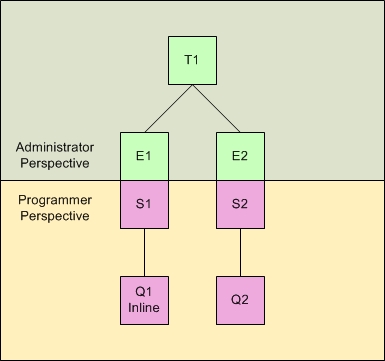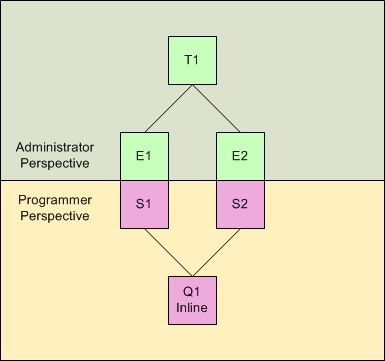Transport Restrictions with Inline Mode
Inline mode restricts underlying transports. Read this entire topic carefully to ensure proper conformance with the restriction.
Violating this principle results in an illegal state exception. (The add subscriber API call throws this exception when the program attempts to add a subscriber that would violate the principle.)
When specifying inline mode, programmers must coordinate with administrators to avoid illegal state exceptions.
Programmer Violation
The first diagram illustrates the simplest violation, attributable entirely to programmer error. The programmer creates two subscribers (S1 and S2) from a single endpoint (E1), and adds them to two event queues, at least one of which (Q1) is an inline queue. This situation would associate the underlying transport (T1) of the subscribers with two incompatible queues (Q1 and Q2), violating the restriction.
To rectify the violation, either add both subscribers to a single inline event queue (Q1), or to two ordinary event queues, neither of which use inline mode.
Hidden Violation
While it would appear straightforward for programmers to avoid the violation of the simple case of the first diagram, the situation is more complicated because responsibilities are divided between programmers and administrators.
From a programmer’s perspective, transports are ordinarily hidden behind endpoint names. Conversely, administrators can ordinarily employ transports to implement endpoints without understanding the specifics of subscribers and queues in application programs. However, inline mode tightly couples transport I/O to program code, which in turn blurs the usual separation of responsibilities between programmer and administrator. As a result, the restriction requires that programmers and administrators coordinate whenever a program uses inline event queues.
Consider the following example. The situation in the second diagram might appear correct from the separate perspectives of the programmer and the administrator, but combining their perspectives reveals a hidden violation.
The programmer instantiates two subscribers (S1 and S2) on two separate endpoints (E1 and E2), and associates them with separate queues (Q1 and Q2). Q1 is an inline queue.
Meanwhile, the administrator employs a single transport (T1) to implement the two endpoints (E1 and E2).
Because T1 is associated with Q1, which is an inline queue, this arrangement violates the principle. When the program adds S2 to Q2, the add subscriber call throws an exception, whether or not Q2 uses inline mode.
By coordinating their information, the programmer and administrator can cooperate to avoid the violation in any of three ways:
- Use ordinary queues instead of inline mode.
- Use separate transports to implement the two endpoints E1 and E2 (see Separate Transports to Correct a Violation, which follows).
- Add subscribers S1 and S2 to only one inline queue (see Single Queue to Correct a Violation, which follows).




